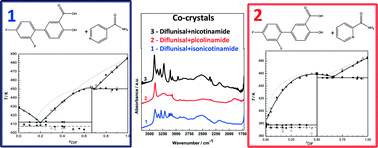Co-crystals of diflunisal and isomeric pyridinecarboxamides – a thermodynamics and crystal engineering contribution†
Abstract
Diflunisal is an anti-inflammatory, non-steroidal drug, class II of the Biopharmaceutical Classification System, which has recently been the subject of renewed interest due to its potential for use in the oral therapy of familial amyloid polyneuropathy. In this study, a thermodynamics based approach is used to investigate binary mixtures (diflunisal + picolinamide and diflunisal + isonicotinamide) in order to identify solid forms that are potentially useful to improve the biopharmaceutical performance of this active pharmaceutical ingredient. Special emphasis is placed on the research of co-crystals and on the influence of structural changes in the pyridinecarboxamide co-former molecules for co-crystal formation with diflunisal. The thermodynamics based methodology described by ter Horst et al. in 2010 indicates that the formation of co-crystals is thermodynamically feasible for both systems. The binary solid–liquid phase diagrams were built and allowed unequivocal identification of the formation of co-crystals of diflunisal with each of the two isomers and also their stoichiometry of 1 : 1, (diflunisal : co-former) in the case of pyridine-2-carboxamide (picolinamide) and (2 : 1) for pyridine-4-carboxamide (isonicotinamide). Two binary eutectic mixtures, potentially relevant for pharmaceutical application, were also identified. Infrared spectroscopy allowed the identification of the acid⋯N-pyridine heterosynthon in the three co-crystals formed by diflunisal with the isomeric pyridinecarboxamides. However, the results clearly differentiated pyridine-2-carboxamide from pyridine-3-carboxamide and pyridine-4-carboxamide, that share similar crystalline arrangements, at least with respect to the supramolecular synthons.


 Please wait while we load your content...
Please wait while we load your content...